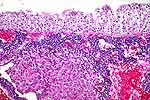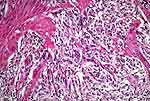 |
Figure 1: This is the classic appearance of a
bladder paraganglioma. The cells are arranged in aggregates or
"zellballen". |
 |
Figure 2: This paraganglioma has cells with a
tinctorial cytoplasmic appearance very similar to those of the normal
adrenal medulla. Note also the prominent vascularity. |
 |
Figure 3: Same case as figure 2. Positive
chromogranin. |
 |
Figure 4: This paraganglioma shows in its
periphery and near the bladder epithelium at the top, small, dark,
"neuroblastoma-like" cells (arrows). These cells are not always present.
|
 |
Figure 5: This is another paraganglioma, showing
an uncommonly prominent layer of "neuroblastoma-like" cells near the
bladder epithelium. |
 |
Figure 6: This tumor shows the "zellballen"
morphology and, in figure 7, it shows widespread dispersion through the
muscularis propria. |
 |
Figure 7: Widespread dispersion through the
muscularis propria (same case as figure 6). Malignancy should be
suspected. This one showed lymph node metastasis.
|

